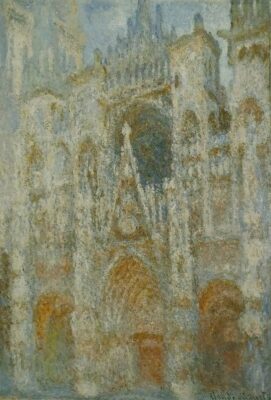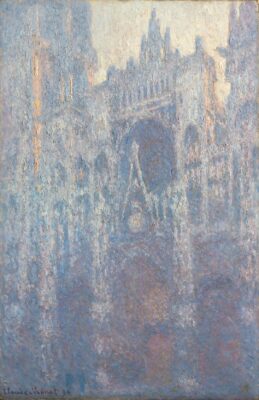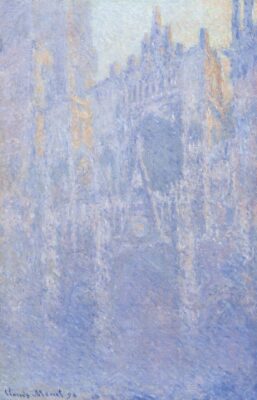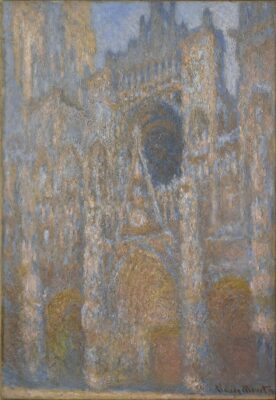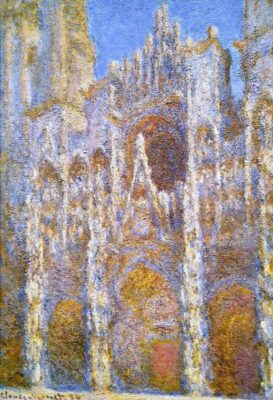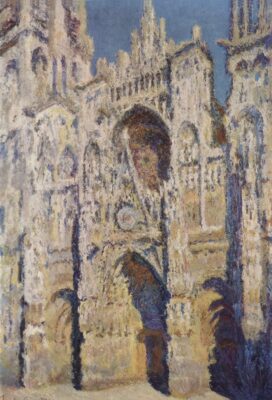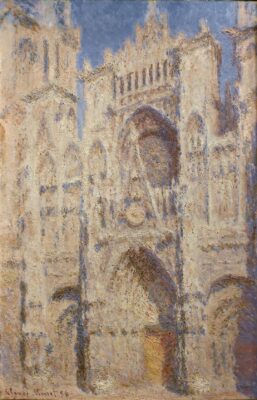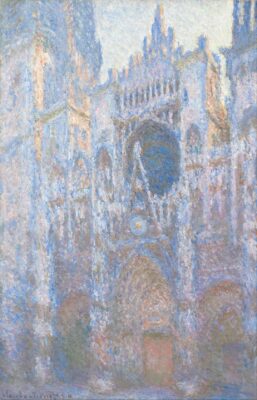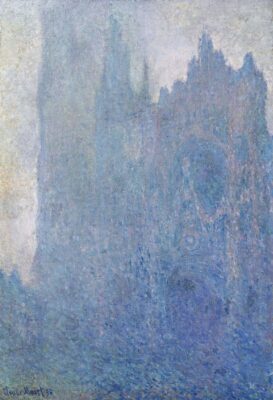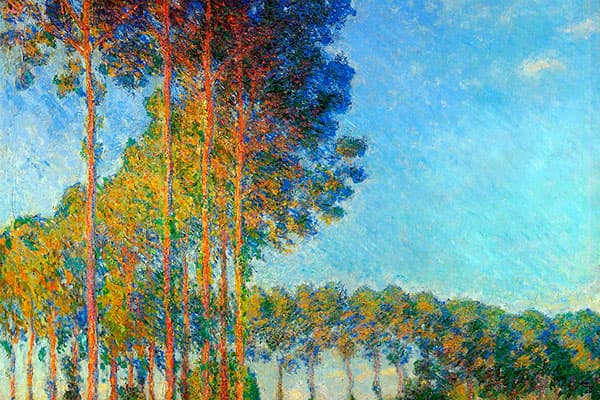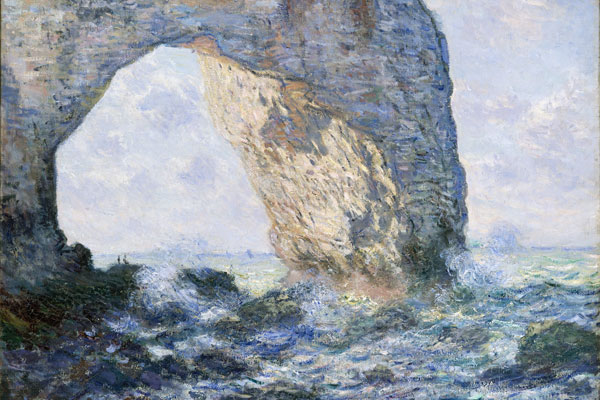The Rouen Cathedral by Monet
CLAUDE MONET – THE ROUEN CATHEDRAL SERIES- THE CLIMAX OF IMPRESSIONISM
“The older I become the more I realize of that I have to work very hard to reproduce what I search: the instantaneous. The influence of the atmosphere on the things and the light scattered throughout”
Claude Monet, 1891
“The climax of Impressionism” . This is how Claude Monet’s series of views of Rouen Cathedral painted between 1892 and 1894 has been described. The series – consisting of 31 canvases showing the façade of Rouen’s Gothic cathedral under different light and weather conditions – provoked immediate admiration among the critics of its time, and was praised by many later masters, from Wassily Kandinsky to Roy Lichtenstein.
by G. Fernández – theartwolf.com
The representation of a same element at different moments with the aim of observing the changes caused by the natural light was not new for Monet, who between 1890 and 1891 had already created a series of 15 canvases representing a group of haystacks in the outskirts of Giverny. These haystacks had been painted under the summer sun, at sunrise and at sunset; at the end of the summer, during the heart of the winter, or on early spring. The paintings are the result of Monet’s interest for the dynamic nature, not of any pictorial or scientist theory (Monet himself declared that “I have always hated those awful theories“). The series was praised by critics, being also a great commercial success. Wassily Kandinsky had the opportunity of seeing one of these haystacks in an exhibition in Moscow in 1895, and he was impressed to the point of suggesting them as the first abstract painting in the history of Art: “And suddenly, for the first time, I saw a picture. I read in the catalogue that it was a haystack, but I could not recognize it (…) I realized that there the object of the picture was missed (…) What I had perfectly present was the unsuspected -and until then hidden- power of the palette…“
1. Claude Monet: “La Cathédrale de Rouen. Le portail, soleil matinal ; harmonie bleue“. 1892-93. Paris, Musée d’Orsay ·· 2. Claude Monet: “Le Portail, effet du matin“. 1893. Getty Museum ·· 3. Claude Monet: “Le Portail, brouillard matinal“. 1894. Musée Folkwang, Essen ·· 4. Claude Monet: “La Cathédrale de Rouen. Le Portail, effet du matin“. 1894. Fondation Beyeler
But with the Cathedral series Monet went even beyond: here the aim is not to represent a tangible model -as it happened in the haystacks paintings- under different light and climatic conditions. In the Rouen Cathedral series, the authentic protagonist is not the architectonic model, in a certain sense “despised” by Monet, who used an extremely nearby point of view, in such way that architecture, due to the almost complete absence of perspective, loses its grandeur and it is even sectioned in the towers and pinnacles. So the building is here not more than a background, an “excuse”, to show the authentic protagonist of the composition: the power of painting for representing the dynamic quality of the light and the atmosphere, capable of giving life to something as stony and inanimate as the imposing facade of the Gothic Cathedral. That what Kandinsky was able to decipher in the haystacks is here more than evident.
Of course, Monet was obviously unable to represent in a complete canvas the fleetingness of a single moment, so he usually worked simultaneously in several canvases, focusing on a particular one whenever the conditions of light and atmosphere were the appropriates. Let’s imagine the situation: Claude Monet installed next to the window of a second floor in front of the Cathedral, working frenetically with tens of canvases, at the mercy of that a fleeting cloud, an unexpected sun ray or an early morning fog forced him to look for a picture in which the new atmospheric conditions could be reflected. Of course, such task had to be exasperating, and the painter was on the verge of giving up the series. But Monet was not a man who easily surrender: “More than ever I detest the things in which I have success at the first attempt “, he had wrote while working on the haystacks series. Monet was even forced to finish several canvases of the Cathedral in his own workshop, entrusting the success of the series to his wonderful visual memory. But two years later, the mission was fulfilled, and Monet had already finished thirty views of the Cathedral. Thus, and for the first time in the history of painting, an artist had managed to represent the fourth dimension, the time, a feat vindicated by several vanguards decades later.
5. Claude Monet: “La Cathédrale de Rouen. Le portail et la tour Saint-Romain, plein soleil ; harmonie bleue et or“. 1892-93. Paris, Musée d’Orsay ·· 6. Claude Monet: “La Cathédrale de Rouen. Le Portail et la tour Saint-Romain, plein soleil“. 1893. Paris, Musée d’Orsay ·· 7. Claude Monet: “Le Portail de la cathédrale de Rouen au soleil“, 1894. Metropolitan Museum of Art, New York ·· 8. Claude Monet: “La Façade de la cathédrale de Rouen au soleil“, 1894. Clark Art Institute
Evidently, among the 31 canvases of the Cathedral series there are more differences than those caused by the different conditions of light and atmosphere. Monet chose five different points of view – two from the square and three from different rooms in the building in front of the Cathedral- representing the Cathedral’s portal (frontally or with the point of view slightly displaced to the right), or the portal and the d’Albane tower (to the left of the portal), but always conserving that unusually nearby point of view. 25 of these views are dated 1894, another one is dated 1893, and five are signed but not dated. However, as Monet finished most of the paintings in his workshop, it is more important the date in which each canvas was started (mostly 1892 and 1893). The election of the palette reflects the different shades in which the daily light was dyeing the Cathedral’s facade: from the smooth blues of the morning (images 1 to 4) to the vivid ochre and golden shades in the soleil pictures (fig 5 to 8), and browns and greys in the cloudy days (fig 9 and 10).
9. Claude Monet: “LCathédrale de Rouen, façade ouest“, 1892. National Gallery, Washington ·· 10. Claude Monet: “La Cathédrale de Rouen dans le brouillard“, 1894. Private collection
Contrary to many other audacious impressionist projects, Monet’s Cathedrals series enjoyed an immediate acceptance among critics and collectors. “Monet causes that even the stones come to life“, declared writer Georges Clemenceau. In May 1895, Monet selected 20 of these canvases to be exhibited in the gallery of his friend and art dealer, Paul Durand-Ruel. In spite of the elevated price of each one of the views – between 12,000 and 15,000 francs- the sale was a huge success. And more than a century later, success has not left Monet: in May 2000, Sotheby’s auctioned one of these Cathedral canvases (“Le portail, soleil”) for more than $24 million.
The best reflections about this series can be found in a letter that Monet himself sent to his friend Clemenceau, revealing that “I have always observed what the world showed me, only to give testimony of it in my paintings“. For his part, Clemenceau, in an essay about the vision entitled Pan and dated 1896, expressed, talking about Monet’s Cathedrals: “In front of the twenty views of the building by Monet, one notices that the Art, in its persistence of expressing the nature with increasing exactitude, teaches us to watch, to perceive, to feel. The stone itself is transformed into an organic substance, and one can feel how it changes in the same way that a little moment of the life is followed by another one. The twenty chapters of samples of light in evolution have been wisely selected to create an ordered guideline of this evolution. The great temple is in itself a testament of the unifying sunlight, and sends its mass against the brightness of the sky“
Although it is in the “Poplars” series in which Monet showed his greatest level of lyricism, and it is in the “Nympheas” group where he reached accomplishments that went far beyond the pure impressionism, even outlining pure abstraction; the series of views of the façade of the Rouen Cathedral is -as it have already been written- the algid point of Impressionism. More than a century later, and dispersed among several museums and private collections of the world, mostly in France and the United States; the views of the Cathedral by Monet are not only artworks coveted by any Museum or serious Art collector, but also the best pictorial testimony of the incomparable courage of Impressionism.
Follow us on:

